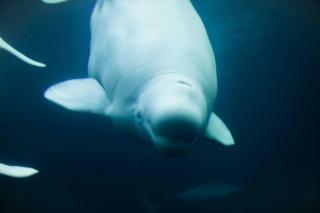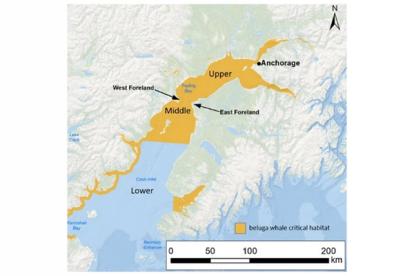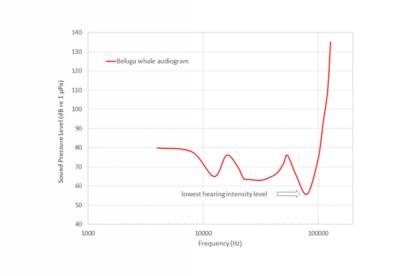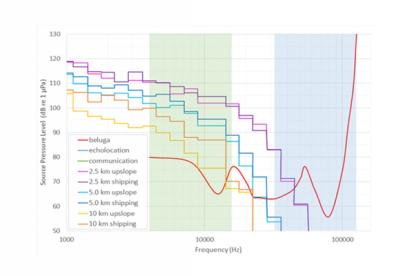
Underwater acoustics research: noise impact on beluga whales by containerships
- Post Date
- 03 February 2023
- Read Time
- 5 minutes

Join us for a TWO-DAY training session, offered in-person and virtually, will teach you about underwater sound, commercial vessels, and mitigating underwater radiated noise (URN).Day One introduces the concept of underwater noise, scales of measurement, impacts on marine biota, and strategies for mitigation. Day Two focuses on the history of commercial shipping, vessel types, source-level measurements, quiet ship classification, energy savings devices, and alternative means of propulsion. Learn more and register here.
Beluga whales are threatened by climate change, contaminants, impacts on critical habitat, predation, prey limitations, and underwater noise. In recent decades, industrial development in Cook Inlet, Alaska has contributed to shipping noise over decades and has raised concerns about the beluga population declining by nearly 80 percent since 1979, from about 1,300 whales to an estimated 279 whales in 2018.
The problem
The beluga whale habitat in Cook Inlet overlaps with shipping lanes, exposing them to underwater noise.
According to the latest status review of beluga whales, they primarily remain in the upper inlet north of the East and West Forelands, with short trips to the lower inlet. A recent vessel traffic study in Cook Inlet showed that most vessels, including cargo, tanker, and passenger vessels, run alongside the deep limits of the shipping channel. A total of 480 transits (self-propelled vessels) are made on an annual basis in Cook Inlet.
Human-caused (anthropogenic) noise sources, such as those by containerships, can cause auditory masking in beluga whales and other marine mammals.

Map indicating beluga whale critical habitat and project site location in Cook Inlet. Source: Alaska marine mammal stock assessments, 2020 (noaa.gov).
Auditory masking occurs when the ability of an animal to detect or recognize a sound of interest is obscured by the presence of another sound. Auditory masking of beluga whales by ships for hours, compromises the beluga population's abilities to communicate and echolocate (locating food, and underwater navigation). Marine mammals exposed to loud background noise have been observed to change their vocal behaviors to compensate for noise levels.
Methodology
For our study, we used the published hearing measurements of a beluga calf in Cook Inlet that showed similar results to healthy, adult belugas. Beluga whale hearing is among the best of all toothed whales. Beluga whales can hear frequencies as low as 40 Hz and as high as 150,000 Hz, including sounds with low intensities (such as 60 dB re 1µPa, indicated in the audiogram below).
Pulsed signals of beluga whales can be classified into two categories:
- communication calls that can extend up to 16,000 Hz and
- echolocation clicks reaching up to 120,000 Hz

Beluga whale audiogram
Broadband (wide frequency range) sound pressure levels (SPLs) are used extensively in Sound Transmission Loss Modeling (STLM); however, when considering auditory masking, narrowband (reduced frequency range) spectral characteristics and levels are key metrics for assessing impacts. Modeled SPL spectra, at increasing ranges from the containership are plotted against an audiogram of a beluga whale measured in Cook Inlet. As a result, masking at different frequencies over the communication and echolocation bands of beluga whales (4,000 – 100,000 Hz) were expected.
We chose two scenarios to model the transmission loss of the source signal and underwater radiated noise (URN) through the shipping channel and upslope (coastal waters).
Results
Bottom figures show ocean floor cross-sections of the shipping channel and upslope of 10 km from the containership (acoustic source) for one site location.

Sound modelling results of cross-sections scenarios: shipping channel (top) vs. upslope (bottom)
The initial perception is that the closer the containership is to the beluga whale, the more likely it is that a higher degree of auditory masking will occur. However, the noise effects are frequency-dependent on the beluga hearing frequency range.
For example, the communication band (indicated in green in the image below) of the beluga whale is completely masked by ambient noise and URN from a containership up to a range of 5,000 m and partially masked to a range of 10,000 m and beyond. In contrast, the echolocation band (indicated in blue in the image below) is partially masked up to a range of 2,500 m from the container ship, being free of any masking effects at longer ranges. Also, the broadband spectral source levels are higher for the shipping channel than in the upslope scenario as shown in the figure below.

SPL from containership at different ranges in the shipping channel and upslope masked with beluga whale band frequencies for communication (green) and echolocation (blue).
Conclusions
There is no evidence of masking within the echolocation band when beluga whales are more than 5,000 m away from noise sources such as containerships. Also, the upslope helps to reduce the source levels. It can be inferred that this could be one of the reasons why Cook Inlet's beluga whale pods are generally seen in shallow coastal waters away from shipping lanes.
In regional trials, lower transit speeds have proven effective in reducing underwater noise from containerships. However, the success of a slowdown initiative within critical habitat for the beluga whale in Cook Inlet is subject to further study, STLM, and in-situ acoustic measurements.
How can SLR help?
The underwater acoustics team at SLR Consulting Canada has undertaken extensive research into the potential effects of underwater noise emissions on marine fauna in combination with detailed empirical/numerical modelling techniques and consultation with experts from our in-house ecology team. We are therefore able to guide and assist you to determine the potential zones of impact for specific species, whether it be for large marine mammals, turtles or fish, and the corresponding relevance to the proposed construction or operational activities you may have.
This full research has been published in Transportation Research Record: Journal of the Transportation Research Board.
- Eickmeier J, Vallarta J. Estimation of High-Frequency Auditory Masking in Beluga Whales by Commercial Vessels in Cook Inlet, Alaska. Transportation Research Record. June 2022. doi:10.1177/03611981221103230
Recent posts
-

-

Understanding sound flanking: Fire alarm speaker cable conduits in multi-family buildings
by Neil Vyas
View post -
